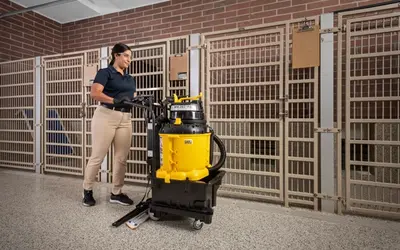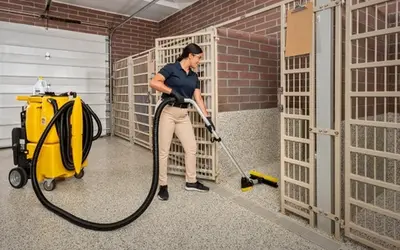Corrections Cleaning for Health, Safety, and Well Being

The Bureau of Justice estimates that federal prisons, state prison, and local jails housed over 2,000,000 people as of 2015. Corrections facilities have a responsibility to create clean, healthy spaces for inmates. Corrections cleaning for health, safety, and wellbeing involves overcoming many challenges unique to these facilities.
“Most jails and prisons were constructed to maximize public safety, not minimize the transmission of disease,” says Joseph Bick in his paper Infection Control in Jails and Prisons. For example, prison design often leads to overcrowding while limiting hand washing opportunities for inmates. This leads to an increased risk of acquiring blood borne pathogens, MRSA, tuberculosis, influenza, and more. Proper corrections cleaning helps keep inmates, staff, and visitors healthy.
Robust Materials
Common flooring materials like vinyl composite tiles, sheet goods, and carpet withstand heavy-duty use. Unfortunately, correctional facilities can’t use the most popular flooring choices. These flooring types use water-based adhesives which means the materials can be picked at, lifted off, and shaped into a weapon.
Instead jail and prison designers choose flooring systems that bond permanently to the concrete substrate. These seamless materials resist harsh cleaners and don’t absorb urine or other fluids. Floor-to-wall cove bases reduce corners where moisture and microbes accumulate. Additionally, antimicrobial protection can be baked into the material.
The same thinking goes into choosing fixtures like toilets and sinks. Heavy gage stainless steel withstands more abuse than porcelain. Seamless welding eliminates the possibility of voids or cervices that conceal contraband. Additionally, the design of these materials makes them easy to maintain.
Cleaning the Right Way
Unfortunately, in many institutions, corrections cleaning means mopping the floor with a single or double bucket and wiping fixtures with cloths. Cleaning Industry Research Institute reports show that mops and cloths spread soils and germs as they go, leaving floors and surfaces dirty after cleaning.
Mops limit cleaning quality, because they absorb a limited amount of soil and liquid. Once saturated, a mop simply paints the floor with contaminated cleaning solution. In order to effectively remove contaminated solution from the floor, correctional facilities turn to vacuum-powered systems, like No-Touch Cleaning. These technologies completely remove pathogens and soils, leaving floors and surfaces dry, clean, and safe.
Learning Skills
For the last 50 years, the Cleaning Management Institute offered custodial certification programs to inmates. Their curriculum covers cleaning best practices. They encourage inmates to clean their facilities at the highest level. This not only creates a safer, healthier interior. Beyond that, inmates leave the facility with enhanced career opportunities to reenter society.
Click here for corrections cleaning machines and sanitizing tools.
Related Posts

The Best Dog Kennel Cleaning Equipment
There are ways to simplify the kennel cleaning process. Automatic kennel cleaning equipment can simplify the kennel cleaning process and can save hours of daily, back breaking labor–even for facilities without central drains.
Read more
A Better Retail Floor Care Option: How One National Retailer Reclaimed Floor Care
Discover how a national retailer cut costs and improved results by switching to Kaivac’s All Floor™ system—an easy, all-in-one floor care solution perfect for low-revenue retail locations.
Read more
The Prodigal Pooch Loses Odors, Gains Clients Thanks To No-Touch Cleaning System
The change at The Prodigal Pooch was immediate. After just two days of using No-Touch Cleaning the look, smell, and feel in the kennel rooms improved. Two weeks later the odor was completely gone.
Read more